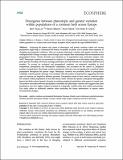Por favor, use este identificador para citar o enlazar a este item:
http://hdl.handle.net/10261/98771COMPARTIR / EXPORTAR:
 SHARE SHARE
 CORE
BASE CORE
BASE
|
|
| Visualizar otros formatos: MARC | Dublin Core | RDF | ORE | MODS | METS | DIDL | DATACITE | |

| Campo DC | Valor | Lengua/Idioma |
|---|---|---|
| dc.contributor.author | Villellas, Jesús | - |
| dc.contributor.author | Berjano, Enrique Regina | - |
| dc.contributor.author | Terrab, Anass | - |
| dc.contributor.author | García González, María Begoña | - |
| dc.date.accessioned | 2014-06-23T10:56:41Z | - |
| dc.date.available | 2014-06-23T10:56:41Z | - |
| dc.date.issued | 2014 | - |
| dc.identifier | doi: 10.1890/ES13-00291.1 | - |
| dc.identifier | issn: 2150-8925 | - |
| dc.identifier | e-issn: 2150-8925 | - |
| dc.identifier.citation | Ecosphere 5(5): (2014) | - |
| dc.identifier.uri | http://hdl.handle.net/10261/98771 | - |
| dc.description.abstract | Analyzing the pattern and causes of phenotypic and genetic variation within and among populations might help to understand life history variability in plants, and to predict their responses to changing environmental conditions. Here we compare phenotypic variation and genetic diversity of the widespread herb Plantago coronopus across Europe, and evaluate their relationship with environmental and geographical factors. Genetic diversity was estimated in 18 populations from molecular markers with AFLP. Phenotypic variation was measured in a subset of 11 populations on six life history traits (plant size, plant growth, fecundity, seed mass, mucilage production and ratio between two functionally different seed morphs). To account for ecological and geographical correlates, we estimated variability in local temperature, precipitation and intraspecific competition, and accounted for the central vs. peripheral position of populations. Phenotypic variation and genetic diversity were not significantly correlated within populations throughout the species' range. Phenotypic variation was positively linked to precipitation variability, whereas genetic diversity was correlated with the position of populations, suggesting that both types of variation are shaped by different processes. Precipitation seems to have acted as a selective agent for variation within populations in most life history traits, whereas the species' post-glacial demographic history has likely reduced genetic diversity in northern peripheral populations with respect to central ones. The positive association between precipitation variability and phenotypic variation also suggests that plant populations may have higher adaptive potential in ecologically variable rather than stable environments. Our study offers an additional criterion when predicting the future performance of species under environmental changes. © 2014 Villellas et al. - Copyright by the Ecological Society of America | - |
| dc.description.sponsorship | This study was funded by the Spanish Ministry of Science and Innovation by means of National Projects to M.B.G. (CGL2006-08507; CGL2010-21642) and A.T. (CGL2009-08713), and a FPU scholarship to J.V. We are grateful to A. Adsuar, A. Barcos, R. Braza, R. Castillo, M.L. Dehesa, R. Corrià, F. Domínguez, R. Forrest, M.C. García, E. López, J. Martínez, E. Morán, C. Niklasson, F. Ojeda, J.M. Olesen, S. Palacio, I. Pardo, A. Pérez, A. Primilla, C. Pérez, P. Sánchez, A. Taboada, M. Talavera and A. Vale for their valuable help in field and laboratory work through years. We thank R. Braza, V. Simón, J. Thompson and A. Traveset for plant material for genetic analyses, R. Braza for phenotypic data from population F and BN, and M. Pazos for her assessment in statistical analyses. X. Picó, J. Arroyo, T. Iriondo, P. Vargas and three anonymous referees provided very helpful comments on the manuscript. | - |
| dc.publisher | Ecological Society of America | - |
| dc.rights | openAccess | - |
| dc.subject | Phenotype | - |
| dc.subject | latitudinal gradient | - |
| dc.subject | Genotype | - |
| dc.subject | range margin | - |
| dc.subject | European Atlantic coast | - |
| dc.subject | environmental fluctuations | - |
| dc.subject | Adaptive variation | - |
| dc.subject | Plantago coronopus | - |
| dc.subject | rainfall | - |
| dc.subject | widespread short-lived perennial | - |
| dc.subject | evolutionary potential | - |
| dc.title | Divergence between phenotypic and genetic variation within populations of a common herb across Europe | - |
| dc.type | artículo | - |
| dc.identifier.doi | 10.1890/ES13-00291.1 | - |
| dc.relation.publisherversion | http://dx.doi.org/10.1890/ES13-00291.1 | - |
| dc.date.updated | 2014-06-23T10:56:42Z | - |
| dc.description.version | Peer Reviewed | - |
| dc.language.rfc3066 | eng | - |
| dc.type.coar | http://purl.org/coar/resource_type/c_6501 | es_ES |
| item.openairecristype | http://purl.org/coar/resource_type/c_18cf | - |
| item.fulltext | With Fulltext | - |
| item.cerifentitytype | Publications | - |
| item.openairetype | artículo | - |
| item.grantfulltext | open | - |
| Aparece en las colecciones: | (IPE) Artículos | |
Ficheros en este ítem:
| Fichero | Descripción | Tamaño | Formato | |
|---|---|---|---|---|
| Vilellas_et_al_Divergence_herb_Europe_Ecosphere2014.pdf | 1,45 MB | Adobe PDF |  Visualizar/Abrir |
CORE Recommender
SCOPUSTM
Citations
20
checked on 31-mar-2024
WEB OF SCIENCETM
Citations
20
checked on 24-feb-2024
Page view(s)
326
checked on 18-abr-2024
Download(s)
268
checked on 18-abr-2024
Google ScholarTM
Check
Altmetric
Altmetric
NOTA: Los ítems de Digital.CSIC están protegidos por copyright, con todos los derechos reservados, a menos que se indique lo contrario.
